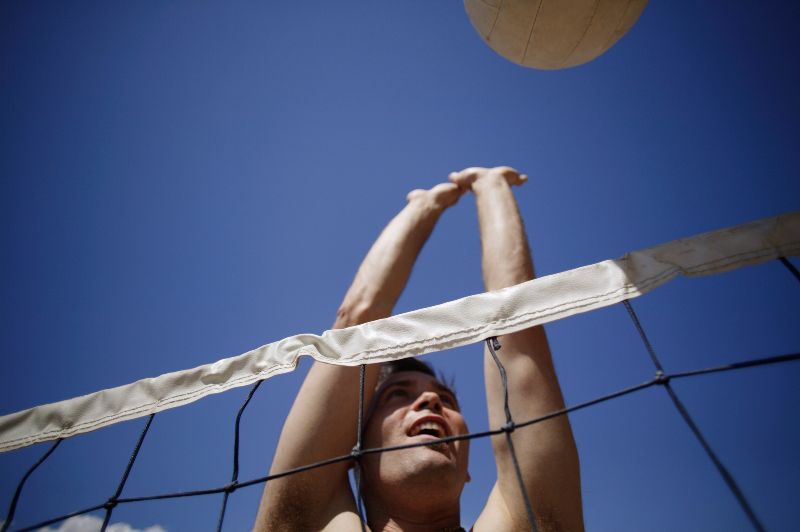
Blocking rules might be a little bit confusing for some new players. Indeed, some of them think that a block would count as a hit in some cases and wouldn’t count as such in others.
In this article, I breakdown all those nuances around blocking in beach volleyball as well as other rules related to this move so it will become second nature for you.
Does a block count as a hit in beach volleyball?
No, a block does not count as a hit in beach volleyball. Indeed, beach volleyball is a sport that has the rule of three…
In other words, each team has three possible contacts with the ball before sending the ball over the net to the opponent’s side.
The first and second contacts are basically positioning of the ball, while the third is intended to reach the opposing team.
A block however is not considered a hit. If 2 players collide over a ball, and a player performs a block and the ball falls over to his side, then his team (his teammates and him) have three hits available (aka: the rule of three).
The condition that has be met for a move to be called a hit is that the block must be performed over the height of the net.
There is however, a soft block which counts as a hit in volleyball. This is contrary to the condition that must be met when performing a block. A soft block is performed under the height of the net and it is considered as a hit in volleyball.
It is logical that a block is not considered as a hit in volleyball. A block is a defensive move that forces a player to have contact with the ball in order to save his team from the opponents possible scoring of a point.
Important Tip: If you are an amateur and not used to hot sand while practicing, the you definitely need to use sand socks. They will also give you a more stability and strength when jumping which would results in better performance overall. For example, these quality sand socks are reliable and will help in that regard.
What counts as a block in beach volleyball?
In beach volleyball blocking is considered as a first contact, so the team of two has two contacts left after the block. That is of course under the condition that the ball goes over the net to the blocking player’s side.
It may seem unfair, but there is a reason for this. If a block is not considered as a hit in beach volleyball, a player could theoretically block the ball, have the first contact, setting the ball right for him and then hitting it for a point. This has been avoided by setting the rules in a way that a block is considered as the first contact.
As unrealistic as it may seem, high level beach volleyball games and players have the ability to do that. The second contact can be executed by any player after the block, which is considered as the first contact.
However, multiple blocking contacts during a single blocking action are considered as the first contact which is logical, since the player that is blocking is defending. When the ball falls over the net to the blocking player’s side, the next contact is regarded as the second contact.
The rules for coed (4 vs 4) and six player team beach volleyball are a little bit different. The block does not count as first contact, but instead after the block the team has three possible contacts, just like in indoor volleyball.
What is an illegal block or screen in volleyball?
Beach volleyball does not have illegal blocking …
We know that indoor volleyball is played six on six, there are two rows of players, the first row has the offensive role, while the back row has a purely defensive role. There are, however fluctuations of the players, where the defensive, back row players get mixed up with the front row players during gameplay.
When this is the case the back row players have no possibility of going in front of the net to perform a block. A defensive player is restricted from blocking the ball, similar to the libero, which may not engage in offensive action.
The defensive players cannot have contact with the ball above the height of the net on the attack line, meaning that they can be stationed near the attack line, but that they may not have offensive contact with the ball.
Another rule that refers to an illegal block is in regards with the interference of the opponent’s attack. A player cannot penetrate the vertical plane of the net while the opponent is attacking, or when the opponent has a chance to attack. The block may take place only after the opponent has attacked.
This rule is fair and it enables the opponent’s team or the team that has the ball to successfully exercise the rule of three, meaning that the entitlement to the three contacts with the ball is guaranteed.
What are the blocking rules in beach volleyball?
Beach volleyball, although similar to indoor volleyball, has some different rules that are crucial to the gameplay and the knowing of the sport.
The illegal tactics when it comes to the interference with the opponents chance to strike stand here as well, because the rules grant the right to three contacts with the ball, and they are guaranteed.
When it comes to legal tactics and performance of a block, there are few things different than those in indoor volleyball.
In beach volleyball blocking is considered as a first contact, so the team of two has two contacts left after the block. That is of course under the condition that the ball goes over the net to the blocking player’s side. The second contact can be made by any player on the team, meaning that the player that blocked the ball can have the second contact.
When it comes to coed and six versus six beach volleyball, the rules are a little bit different. They are the same as in indoor volleyball. The rules state that a block is not regarded as a first contact, but rather as a defensive action. This is because there are more players and the gameplay is stiffer than in 2v2 beach volleyball.
Are those rules similar to indoor volleyball?
A block is not considered a hit in indoor volleyball. If two players collide over a ball, and a player performs a block and the ball falls over to his side, then his team (his teammates and him) have three hits available, the rule of three.
The condition that must be met for a move to be called a hit is that the block must be performed over the height of the net.
The FIVB rules for a block as of 2020 are as follows:
14.4.1. A block contact is not counted as a team hit. Consequently, after a block contact, a team is entitled to three hits to return the ball.
14.4.2. The first hit after the block may be executed by any player, including the one who has touched the ball during the block.
There is however, a soft block which counts as a hit in volleyball. This is contrary to the condition that must be met when performing a block. A soft block is performed under the height of the net and it is considered as a hit in indoor volleyball, making it similar to beach volleyball.
Final Thoughts …
I totally understand that these rules and nuances might sound a little bit confusing when you first read about them. But I promise you that this is totally worth it, because this will not only help you understand the rules …
But also, it will help shape even better your style of playing as you will adapt it so you won’t break those rules.
This will make you overall a better player.
Finally, keep in mind that your beach volleyball skills can well help with your indoor skills …
